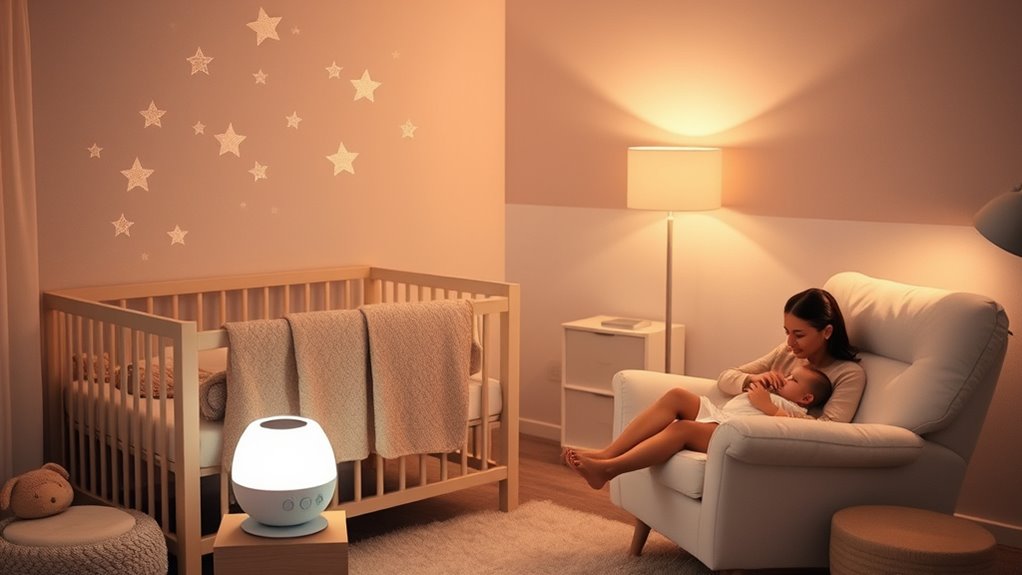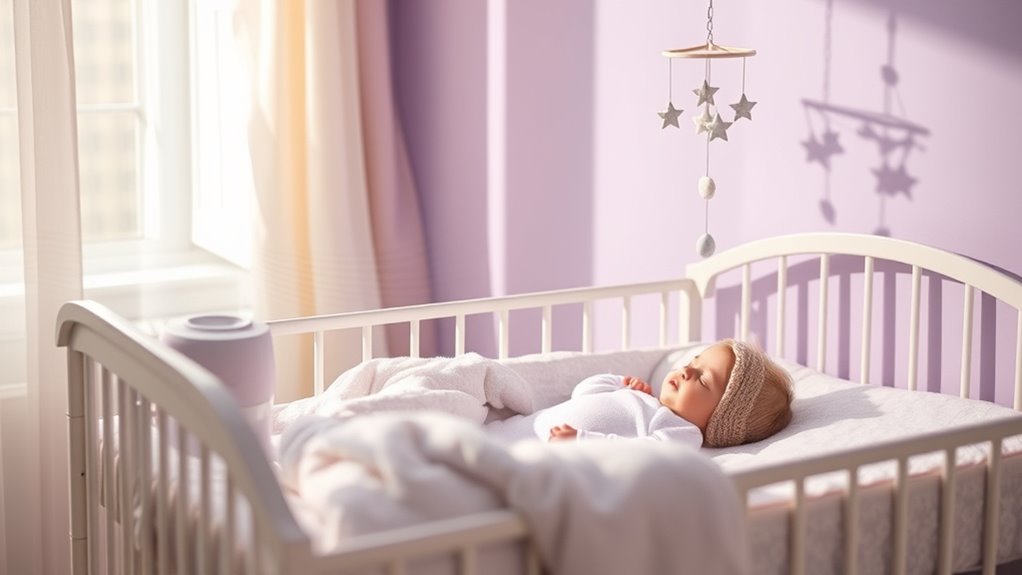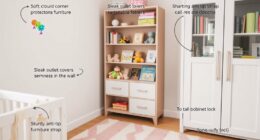To help your baby sleep through noise, create a calm sleep environment and consider using a white noise machine to mask disruptive sounds. Make sure the volume is just loud enough to drown out background noise without startling your little one. Establish a consistent bedtime routine with soothing activities, like baths or lullabies, to signal it’s time for rest. With the right strategies, you can improve your baby’s sleep quality and find effective solutions along the way.
Key Takeaways
- Use a white noise machine to mask environmental sounds and create a calming auditory backdrop for your baby.
- Soundproof the sleep environment with curtains, sealing windows, and using draft excluders to minimize noise intrusion.
- Establish a consistent sleep routine with calming bedtime rituals to help your baby associate activities with sleep.
- Gradually introduce your baby to household sounds, ensuring they aren’t disruptive during sleep, especially during light sleep stages.
- Be patient and persistent in managing noise levels, as babies’ sensitivity typically decreases around six months to one year.

As your baby navigates the world, it’s normal for them to be sensitive to noise, which can disrupt their sleep. Their underdeveloped nervous systems make them more prone to waking during light sleep stages. While they’re used to some noise from the womb, a completely quiet environment can actually be confusing for them.
Fortunately, as they grow, their sensitivity typically decreases around six months to one year. Creating a calm sleep environment is essential for helping them rest better.
One effective way to manage noise is by using white noise. White noise machines can help mask external sounds, promoting a serene atmosphere for sleep. You’ll want to set the volume loud enough to muffle any environmental noise but not so loud that it becomes overwhelming. If used correctly, white noise machines aren’t considered sleep props, and you can also explore apps and playlists that offer soothing sounds for your little one. This consistent auditory background can create a sense of security and stability.
Further, consider soundproofing the sleep environment. Simple measures like using soundproof curtains, sealing windows and doors, and placing draft excluders can significantly reduce external disturbances. These strategies are similar to those that adults might use, and they help create a quiet sanctuary for your baby. High-quality blackout curtains can also dampen noise while keeping the room dark—a crucial factor in signaling it’s time to sleep.
Establishing a consistent sleep routine is equally important. When your baby knows what to expect at bedtime, they’re more likely to settle down peacefully. Consistency in their sleep schedules and bedtime rituals helps them associate certain activities with sleep. Activities like baths or lullabies can be soothing and signal that it’s time for rest.
Remember, avoiding daytime naps doesn’t guarantee better sleep at night; it might just lead to overtiredness.
While managing household noise, keep in mind that familiar sounds usually don’t wake babies, unless they occur during light sleep. Unexpected noises, like a garbage truck, can be disruptive, so maintaining a balance is key.
As your baby grows and becomes less sensitive to noise, you can gradually adjust their sleep environment by reducing white noise volume or introducing new sleep cues. Every baby is unique, so it might take some patience and persistence to find the right strategies that work for you. Additionally, understanding the concept of sleep routines can enhance your approach to helping your baby develop healthy sleep habits.
Frequently Asked Questions
Can White Noise Machines Harm My Baby’s Hearing?
Yes, white noise machines can harm your baby’s hearing if not used properly.
They can produce sounds that are too loud, potentially leading to hearing damage.
It’s crucial to keep the machine at a safe volume—ideally below 60 decibels—and place it at least seven feet away from your baby.
Monitoring for any signs of hearing loss is also essential to ensure your little one’s safety and well-being while using these devices.
What Noises Are Most Disturbing to Babies?
You might think a car horn is like a cannon blast to your baby’s ears!
Common noises that disturb them include loud street arguments, toilet flushes, and trash trucks. Even the hum of air conditioning or the sound of older siblings playing can wake them up.
It’s crucial to recognize these disturbances, as they can significantly disrupt your baby’s sleep.
Keeping their environment quiet is key to promoting restful nights.
How Loud Should White Noise Be for Infants?
When using white noise for infants, you should aim for a volume between 50 to 70 decibels.
However, the American Academy of Pediatrics recommends keeping it at or below 50 decibels to avoid potential hearing damage.
This level helps create a soothing environment while masking disruptive sounds.
Remember to place the machine at least seven feet away from your baby’s sleep area to ensure safety and promote better sleep quality.
At What Age Can Babies Sleep Through Loud Noises?
By around one year, most babies start to sleep through loud noises more easily. As they grow, their nervous systems develop, making them less sensitive to disturbances.
At six weeks, they become more alert and aware of their surroundings, which can make them wake up due to noise. However, with consistent routines and soothing sounds, you can help your baby adapt to their environment and improve their ability to sleep through various sounds.
Can I Use Lullabies Instead of White Noise?
Imagine softly rocking your baby, the room dimly lit, as you hum a gentle lullaby.
You can certainly use lullabies instead of white noise; they create a soothing atmosphere and establish a bedtime routine. As you sing, your baby feels the warmth of your voice, fostering a bond.
While lullabies work wonders for winding down, remember that they mightn’t block out disruptive sounds as effectively as white noise.
Combining both can enhance sleep.
Conclusion
In the grand symphony of life, gentle sounds can be both a lullaby and a disturbance. Embrace the art of soothing your little one amidst the clamor, knowing that with a touch of patience and the right techniques, your baby can drift into peaceful slumber, even when the world outside plays its tune. By creating a cozy haven and introducing white noise, you’ll help nurture their restful nights, ensuring sweet dreams prevail over the hustle and bustle.









